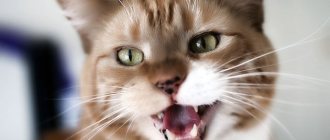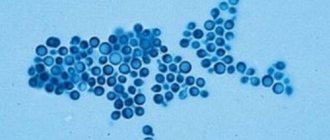Failure of a cat’s hind legs is most often provoked by serious illnesses or previous injuries that require immediate contact with a veterinary clinic. Even the slightest delay can lead to the death of the animal.
Gait disturbances, paralysis of the limbs and spinal injuries can only be cured by a specialist; it is impossible to relieve such conditions on your own. Failure to see a doctor in a timely manner increases the risk of complete loss of sensitivity and mobility of the paws. That is why, in order to avoid complications and return the animal to a confident gait, at the first manifestations of paralysis, you should take the animal to the veterinarian.
Failure of a cat's hind legs: causes of a dangerous condition
Impaired mobility of an animal's limbs can be caused by various reasons. It is very difficult for the owner to independently understand what caused the paralysis, so in this case it will not be possible to do without a trip to the veterinarian.
Failure of a cat's hind legs can be caused by:
- Spinal injuries. Limbs often lose mobility as a result of spinal column injuries. Trauma to the lumbar region especially often leads to such consequences. Animals with access to the outdoors are susceptible to similar injuries. They may be run over by a vehicle or fall from a height or jump awkwardly from a tree. Apartment pets also get injured when jumping from a closet or windowsill. Problems with the limbs are indicated by immobility of the hind legs, tail and general weakness.
- Thrombosis of the femoral arteries. Thromboembolism of the femoral arteries leads to loss of sensation in the limbs, which develops gradually. During its development, the animal experiences severe pain in the lower back, screams and behaves restlessly. If you do not show your pet to a doctor in a timely manner, tissue necrosis will begin and it will be impossible to restore the mobility of the hind legs. In addition, after a few days, thrombosis will lead to death.
- Tick bite. Tick bites, although rare, cause paralysis, leading to the death of the animal. After a tick bite, the animal becomes agitated, followed by weakness, apathy, trembling and paralysis. If action is not taken in time, death occurs.
- Inflammation of the spinal fluid. Myelitis develops against the background of infectious diseases, helminthic infestations, injuries and poisoning. The pathology is characterized by failure of the cat's hind legs, chaotic movements, elevated temperatures, upset stomach, diarrhea and urinary incontinence. Timely treatment will lead to relief of the disease and complete restoration of the mobility of the pet’s limbs.
- Hip dysplasia. With this pathology, bone formation is disrupted. The disease primarily affects large breed cats. The disease leads to the development of severe pain when walking and jumping. If the owner does not provide supportive treatment, this will lead to limb failure.
- Stroke. A cat's hind legs may also fail due to a stroke. The disease can affect both older and young animals as a result of poor nutrition or a sedentary lifestyle. When the cerebral vessels are blocked, paralysis of the limbs develops. Timely treatment, which should begin immediately after diagnosis, will help eliminate it.
- Heart failure. If the cardiovascular system does not work properly, the animal's limbs may fail. This occurs due to oxygen starvation, against the background of which muscle tissue atrophy develops. In addition, heart problems manifest themselves in shortness of breath, dry cough and lethargy.
Other pathologies also lead to loss of limb mobility, which can only be identified by a specialist after a complete examination of the sick cat.
Why and how a dog limps on its hind leg
According to scientific data, lameness in dogs, in approximately 70% of cases, occurs in the hind limbs, of which 50% are diseases of the knee joints.
When a dog doesn't step on its back paw, an unusual gait occurs, and this is the most noticeable symptom that causes dog owners to go to the veterinary clinic.
Symptoms that owners most often pay attention to:
- the dog is limping on its hind leg without visible damage;
- restriction of limb movement while walking;
- the dog does not step on its hind paw - it periodically or constantly holds its paw up;
- unnatural position of the paw when the dog lies or sits;
- the dog often licks or bites a limb;
- periodic spontaneous screaming;
- trembling in the limbs;
- lameness due to acute pain and even in its absence;
- swelling of a joint or some other part of the limb;
- clicks are heard during movement, or a crunching sound (crepitus);
- lameness occurs only under certain conditions, for example, immediately after sleep or only after jumping over an obstacle;
- the presence of fluid (effusion) in the knee joint;
- the dog does not lean on one paw or the other;
- sometimes refusal to eat;
- muscle atrophy - it is clear that the muscle mass of one paw is different from the other.
Symptoms characteristic of limb failure
Paresis of the limbs is represented by the following symptoms:
- complete or partial impairment of motor functions. The animal stops moving quickly, drags its paws or moves crawling;
- change in gait. If swaying and pulling up of the limbs is normal for a small kitten, then failure of the cat’s hind legs requires immediate intervention by a veterinarian;
- atrophy of the muscular system. The muscles of the hind limbs lose their elasticity;
- soreness when feeling the hind legs. The cat screams and struggles when the back of the body is probed;
- lack of sensitivity. The animal stops feeling cold and warmth with its paw pads.
If such symptoms appear, your pet should be taken to a veterinarian immediately.
Degenerative diseases of the spine
The normal functioning of the hind legs in dogs can be caused by diseases of the spine, which are degenerative in nature as a result of metabolic disorders in its tissues. Pathological changes occur in the structure of certain parts of the spinal column.
Discopathy is a disease of the intervertebral discs, accompanied by displacement and destruction of the intervertebral discs. As a result of discopathy, the altered disc substance penetrates the spinal canal and clamps the spinal cord or the spinal nerve roots emerging from the spinal cord.
Clinically, discopathy in dogs is manifested by repeated attacks of severe pain: the dog freezes in one position (usually with an elongated neck and hunched back), severe trembling appears, shortness of breath, the hind legs give way and weaken. If the compression of the spinal cord or spinal roots is insignificant, the dog’s owners note only the weakness of the hind limbs - the dog seems to be dragging them, tries to transfer the body weight mainly on the front paws, cannot jump onto the sofa (chair, armchair), cannot bend over to the bowl or semi.
Older dogs of large and giant dog breeds are most susceptible to discopathy: Great Danes, Rottweilers, German Shepherds, Doberman Pins and others. Clinical symptoms of the disease in these dog breeds usually progress slowly over several months or years.
Discopathy, which is often found in French bulldogs, is associated with the anatomical structure of the dog, when, during artificial selection, the spine of the bulldog became elongated, as a result of which it began to experience stronger loads, unlike the spine of dogs of other breeds. The distance between the vertebrae has become significantly greater than in ordinary dog breeds. Disc prolapse in a French Bulldog can occur not only during jumping, but possibly even during rest, when the dog lies quietly.
Spondylosis
When a dog has spondylosis, “local aging” of some vertebral segments occurs, causing the dog’s hind legs to fail.
Spondylosis as a disease progresses very slowly and therefore, at its early stage, it is practically not detected by veterinary specialists. With spondylosis, the outer fibers of the annulus fibrosus are initially damaged (the consistency of the nucleus pulposus is preserved), and then calcification of the anterior longitudinal ligament begins. Osteophytes develop, which, when examining the dog, especially on an x-ray, look like beak-shaped growths.
Osteocondritis of the spine
Osteochondrosis of the spine in dogs is considered by veterinary specialists to be the most severe form of the lesion. Osteochondrosis is based on degenerative processes in the intervertebral discs, often involving the vertebral bodies surrounding the intervertebral discs. At the same time, with osteochondrosis, changes occur in the ligamentous apparatus and intervertebral joints.
Etiology of osteochondrosis. The causes of osteochondrosis in dogs are:
- Spinal injuries.
- Rheumatoid lesions.
- Violation associated with a malnutrition of the disk (disk microcirculation is disrupted).
- Autoimmune diseases.
- Heredity.
First aid
If the owner notices a failure of the cat’s hind legs or problems with mobility, then before taking it to the veterinarian, he must provide first aid to the animal.
First you need to calm the pet and put it in a carrier or house. Then, if the hind paws are cold, you need to warm them up with a heating pad. After this, you need to immediately go to the veterinary clinic.
What can be considered lameness?
When a dog does not step on its hind paw, or leans on it, but in a very unusual way, or maybe even presses different paws, then the pet is considered to be limping.
Lameness is an unusual gait or posture of an animal. This is expressed by asymmetrical movement of the limbs due to dysfunction of the musculoskeletal system or the manifestation of other diseases of the body.
The dog is limping on its hind leg
If a dog is in pain, it is forced to take care of its paw - do not lean on it again and try to transfer the main weight to the other limb. This is how uneven gait occurs. Pain can be due to problems with joints, bones, muscles, tendons, bursae (periarticular bursa).
But sometimes lameness is a consequence of any abnormal development of the musculoskeletal system (for example, congenital or acquired deformities).
Valgus deformity of the pelvic limbs in a dog
It is important to understand that lameness is not a disease, but a symptom of some disease. The dog walks strangely because something happened to its paw or to its body as a whole. Therefore, initially you need to identify the main cause from hundreds of possible diseases and deal with it, because it is impossible to cure lameness.
How to treat paresis of the lower extremities?
After delivering the cat to the veterinarian, the specialist conducts an examination, determines the degree of sensitivity of the hind limbs, takes an X-ray and ultrasound, and also takes the tailed patient’s blood and urine for analysis.
Therapy is prescribed only after an accurate diagnosis has been made. It includes medication, physiotherapy, massage, and sometimes surgery.
Drug treatment
If paresis of the limbs is confirmed, appropriate drug therapy is selected for the cat. Depending on the disease that caused the paralysis, various drugs are used. They can be presented:
- antibiotics to relieve inflammation caused by infection;
- vitamins to strengthen the immune system;
- drugs that thin the blood for thrombosis and stroke;
- anti-mite drugs;
- diuretics.
The treatment regimen may differ depending on the underlying disease that caused the failure of the cat's hind legs.
Physiotherapy
Recovery from limb paresis is very long and requires mandatory physiotherapeutic procedures.
To help your pet recover faster, veterinarians advise performing a number of exercises that will help restore neurological functions:
- Bike. To perform this exercise, the animal must be placed on its back and alternately perform circular movements with its hind legs for five minutes, simulating riding a bicycle.
- Paw massage. Every day, the owner must knead the cat’s paw pads and the paralyzed limbs themselves.
- Carding. A sick pet needs to be scratched in different places on the body. Progress will become noticeable when the cat, after the next “scratching”, begins to try to scratch itself with its hind paw.
- Rolling on the ball. To do this, take the cat and place it with its stomach on the ball, making sure that its limbs slightly touch the floor. In this position, the animal must be slowly rolled back and forth, holding it by the back.
- Support. You need to pass a wide strip of fabric under your pet's belly and walk with it around the room, holding the ends of the fabric.
- Moving the hind legs. To perform this exercise, you need to grab the animal by the hind legs and slowly move them, imitating walking.
- Swimming in the bathtub. This exercise is suitable for those cats who are not afraid of water. To perform this, the animal must be forced to swim in the bathtub every day, supported under the stomach and head so that it does not swallow water.
"Important! To speed up recovery, after a cat’s hind legs fail, it is necessary to work with it daily, devoting at least an hour a day to physical therapy.”
How can you tell which leg a dog is limping on?
It happens that the owner sees that the dog is limping on its hind leg, but does not understand which one. If there is a limp on the right limb, most will think that the dog is lame on the left paw. The fact is that it is not easy to distinguish between lameness and seizure in a dog.
A fall is a forced transfer of weight to a healthy limb. If the right paw hurts, the animal will try to shift its weight to the left, that is, it will fall on the left paw. This is what owners perceive as lameness. Although in fact the dog is taking care of the right sore limb.
If your pet has short legs, then in order to keep up with you, he has to move very quickly. Therefore, it is very difficult to understand which paw he is limping on. In this case, it is better to make a video recording of the gait, and then watch it in slow motion.
If the dog is short-legged with long hair or very fluffy (for example, a Pekingese), then recognizing lameness becomes even more difficult. After all, the animal walks as if wearing a skirt, under which its short legs are hidden.
But the most difficult thing is when the dog is limping on different legs. This is called intermittent claudication (eosinophilic panosteitis). That is, at one moment there is lameness on one limb, at another - on another, at the third - on a third.
As you understand, without a veterinarian it is very difficult to understand which limb the dog is actually limping on. But, most importantly, you will not be able to understand on your own why your gait is impaired.
YES, WE NEED AN ORTHOPEDIST
What are the consequences of failure of a cat's hind legs?
Failure of a cat's hind legs is a complex ailment that requires immediate treatment at a veterinary clinic. Self-medication of paresis is completely excluded, since it will not give any results and will only worsen the animal’s condition.
In the absence of proper drug treatment, paresis of the limbs can cause death, which will occur within a few days and will be extremely painful for the pet.










